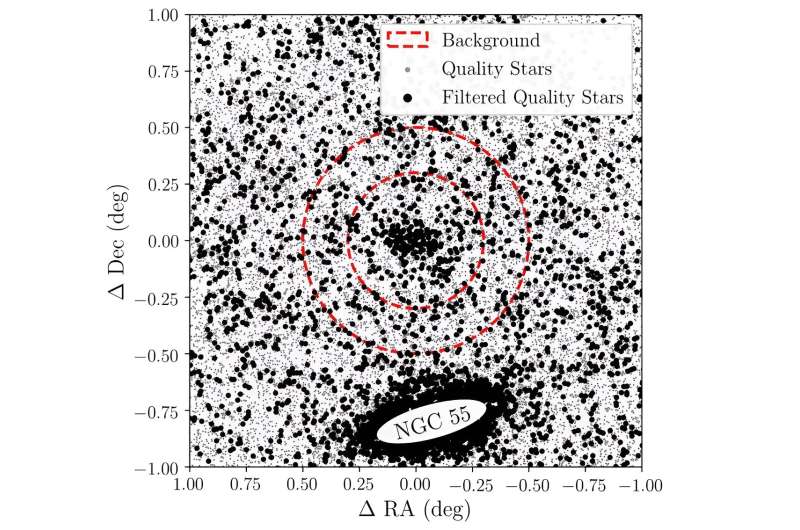September 18, 2023 report
This article has been reviewed according to Science X's editorial process and policies. Editors have highlighted the following attributes while ensuring the content's credibility:
fact-checked
preprint
trusted source
proofread
New faint ultra-diffuse dwarf galaxy discovered

An international team of astronomers reports the detection of a new faint ultra-diffuse dwarf galaxy as part of a systematic wide-area search for faint dwarf galaxies using the Dark Energy Survey (DES). The newfound object, designated NGC 55-dw1, is a satellite of the galaxy NGC 55. The finding was detailed in a paper published September 8 on the pre-print server arXiv.
Ultra-diffuse galaxies (UDGs) are extremely-low-density galaxies. The largest UDGs have sizes similar to the Milky Way, but have only about 1% as many stars as our home galaxy. The mystery of UDGs is still baffling scientists as they try to explain why these faint but large galaxies are not ripped apart by the tidal field of their host clusters.
Recently, a group of astronomers led by Mitch McNanna of the University of Wisconsin-Madison has discovered a new UDG, which turned out to be a satellite of NGC 55—a barred spiral galaxy located about 6.5 million light years away in the constellation Sculptor. The discovery is based on the full six years of DES wide-area survey observations (DES Y6).
"We performed a search over the DES Y6 data for faint field dwarf galaxies with heliocentric distances D = 0.3−2 Mpc using the simple matched-filter search algorithm. This algorithm identifies galaxies as arcminute-scale overdensities of individually resolved stars," the researchers explained.
The newfound UDG, which received NGC 55-dw1, is separated by only 47 arcminutes from NGC 55. Therefore, assuming that the galaxy and its satellite are roughly co-distant, they are separated by only 98,000 light years.
NGC 55-dw1 has an absolute V-band magnitude of -8.0 mag, half-light radius of about 7,200 light years and total stellar mass of around 142,000 solar masses. The galaxy is estimated to be 6.5 billion years old and its metallicity was measured to be at a level of -1.8.
The large spatial extent of NGC 55-dw1 relative to its luminosity makes it unusual among the known population of dwarf galaxies in the Local Volume—within 36 million light years from the Earth. NGC 55-dw1 has one of the lowest surface brightness (32.3 mag/arcsec2) and is the largest, most diffuse galaxy known at this luminosity.
The authors of the paper noted that NGC 55-dw1's large, diffuse nature, high ellipticity (0.56), and proximity to its potential host galaxy suggest tidal interactions with NGC 55. However, further studies are needed in order to confirm this.
"Tidal interactions are a possible explanation for its large size, high ellipticity, and extremely low surface brightness. (...) However, due to the depth limitations of our ground-based imaging, confirmation of tidal stripping will likely require further follow-up," the scientists concluded.
More information: M. McNanna et al, A search for faint resolved galaxies beyond the Milky Way in DES Year 6: A new faint, diffuse dwarf satellite of NGC 55, arXiv (2023). DOI: 10.48550/arxiv.2309.04467
Journal information: arXiv
© 2023 Science X Network





















